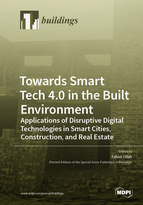Towards Smart Tech 4.0 in the Built Environment: Applications of Disruptive Digital Technologies in Smart Cities, Construction, and Real Estate
A special issue of Buildings (ISSN 2075-5309). This special issue belongs to the section "Construction Management, and Computers & Digitization".
Deadline for manuscript submissions: closed (10 August 2022) | Viewed by 45477
Special Issue Editor
Interests: construction management; digital construction; project management; digital built environment; smart cities
Special Issues, Collections and Topics in MDPI journals
Special Issue Information
The traditional built environment needs a technological transformation in line with the Industry 4.0 requirements to transform into a smart built environment. For this to materialize, disruptive digital technologies must be adopted. Accordingly, the goals of integrated smart cities, construction, and t real estate can be achieved to promote Sustainability in the built environment in line with the United Nations sustainable development goals. Such technologies in line with industry 4.0 requirements (hereby referred to as the Smart Tech 4.0) have been proposed in various fields and include the big9 technologies such as Artificial Intelligence (AI), Internet of Things (IoT), Unmanned Aerial Vehicles (UAVs), Clouds, Big Data, 3D Scanning, Wearable Technologies, Virtual Reality (VR), Augmented Reality (AR), Robotics, Blockchains, Software as a Service (SaaS), 3D Printing, Digital Twins, Ubiquitous Computing, Renewable Energy, Autonomous Vehicles, and 5G Communications. However, currently, the research around the adoption and implementation of these smart technologies is limited. This special issue invites and aims to attract contributions from construction managers, civil engineers, project managers, city and urban planners, real estate and property managers, architects, IT managers, data scientists, software developers, computer systems analysts, web developers, governance management specialists, and others.
Dr. Fahim Ullah
Guest Editor
Manuscript Submission Information
Manuscripts should be submitted online at www.mdpi.com by registering and logging in to this website. Once you are registered, click here to go to the submission form. Manuscripts can be submitted until the deadline. All submissions that pass pre-check are peer-reviewed. Accepted papers will be published continuously in the journal (as soon as accepted) and will be listed together on the special issue website. Research articles, review articles as well as short communications are invited. For planned papers, a title and short abstract (about 100 words) can be sent to the Editorial Office for announcement on this website.
Submitted manuscripts should not have been published previously, nor be under consideration for publication elsewhere (except conference proceedings papers). All manuscripts are thoroughly refereed through a single-blind peer-review process. A guide for authors and other relevant information for submission of manuscripts is available on the Instructions for Authors page. Buildings is an international peer-reviewed open access monthly journal published by MDPI.
Please visit the Instructions for Authors page before submitting a manuscript. The Article Processing Charge (APC) for publication in this open access journal is 2600 CHF (Swiss Francs). Submitted papers should be well formatted and use good English. Authors may use MDPI's English editing service prior to publication or during author revisions.
Keywords
- Smart Technologies in smart cities, construction, and smart real estate
- Disruptive Technologies in smart cities, construction, and smart real estate
- Sustainable smart cities, construction, and real estate
- Building Information Modeling in smart cities, construction, and smart real estate
- Disruptive Technologies for Industry 4.0 and Industry 5.0
- Digital Project Management in smart cities, construction, and smart real estate
- Disruptive Technologies for developing decision support systems
- Big9 Disruptive Technologies in smart cities, construction, and smart real estate
- Unmanned Aerial Vehicles (UAVs) in smart cities, construction, and smart real estate
- Artificial Intelligence (AI) and Robotics in smart cities, construction, and smart real estate
- Internet of Things (IoT) in smart cities, construction, and smart real estate
- Big Data in smart cities, construction, and smart real estate
- 3D Scanning and Wearable Technologies in smart cities, construction, and smart real estate
- Virtual Reality (VR) and Augmented Reality (AR) in smart cities, construction, and smart real estate
- Blockchains and 3D Printing in smart cities, construction, and smart real estate
- Digital Twins in smart cities, construction, and smart real estate
- Autonomous Vehicles and 5G Communications






